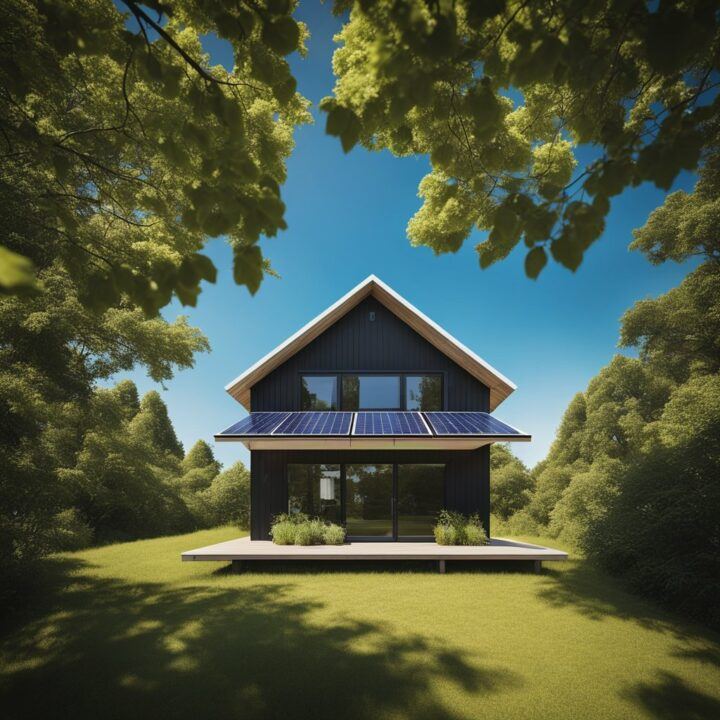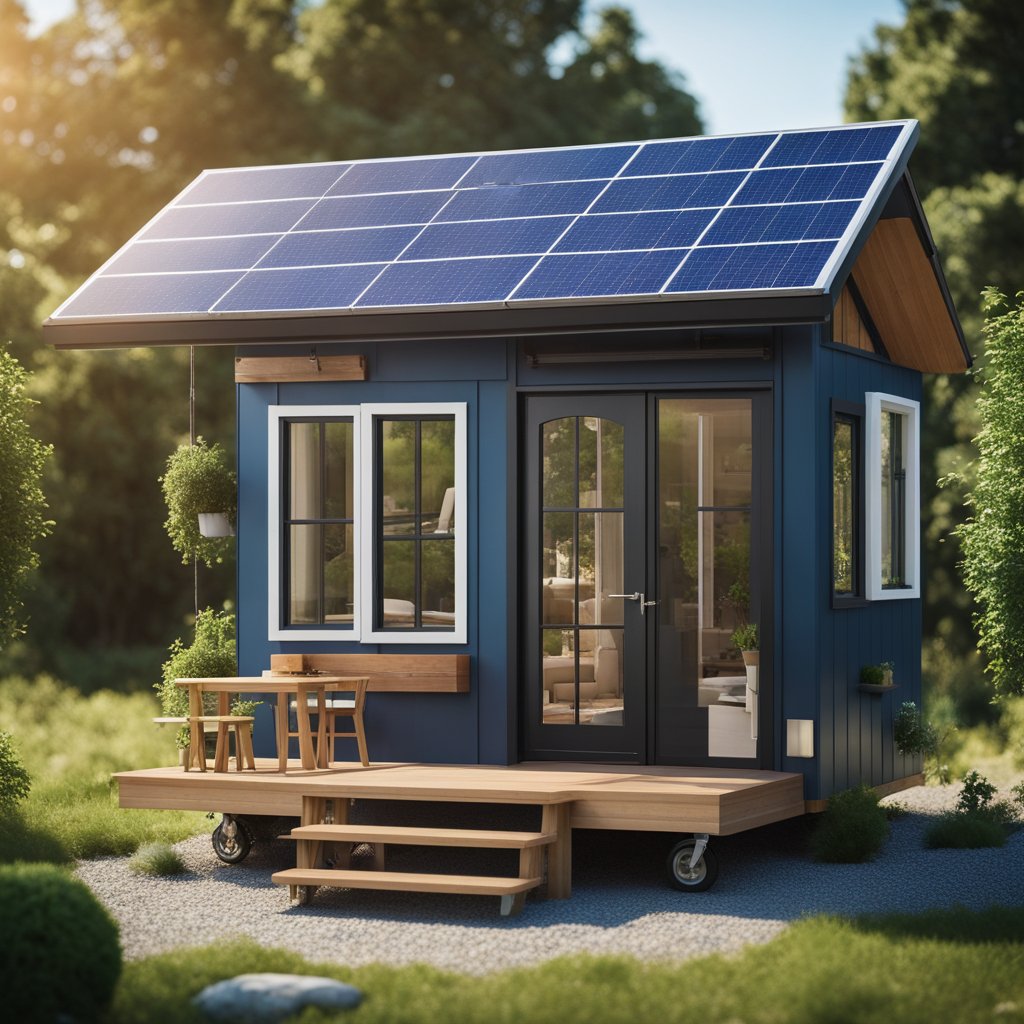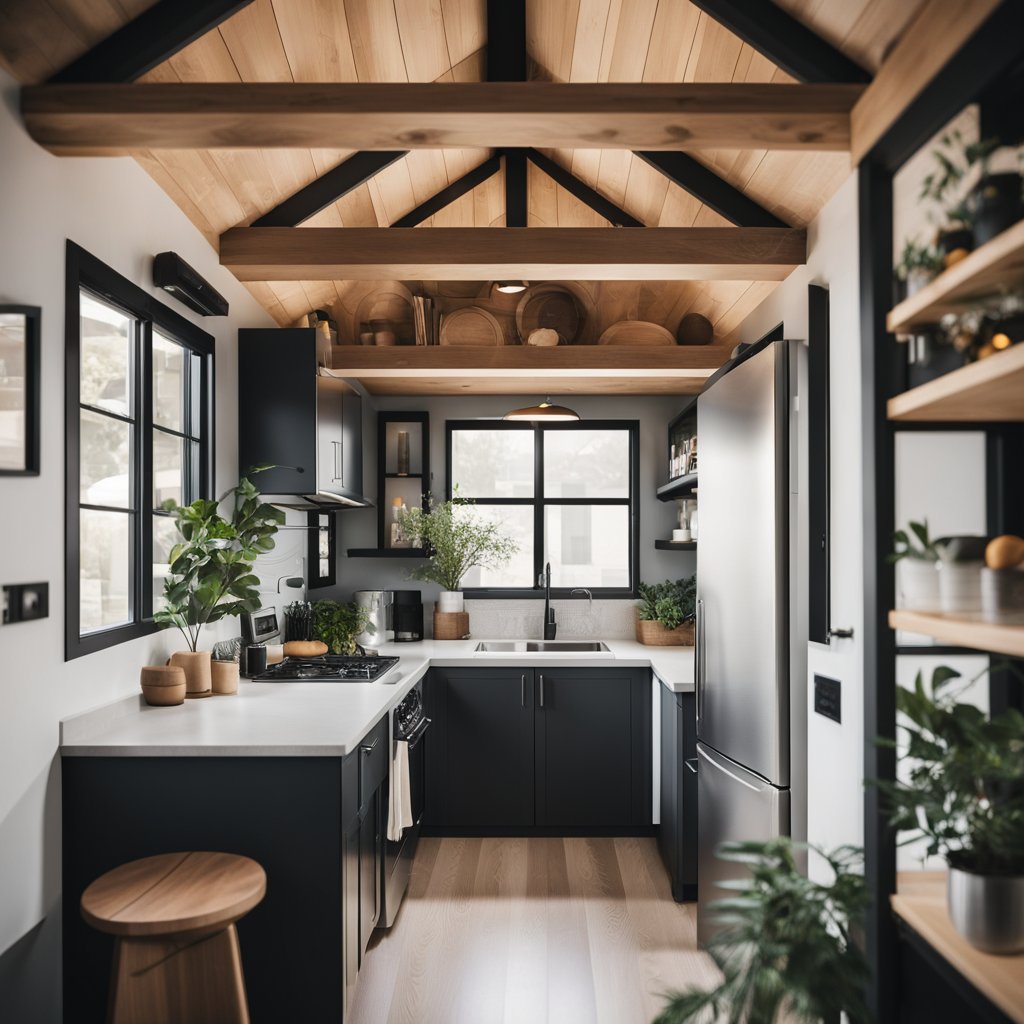Table of Contents
Best Way to Power a Tiny Home: Simple and Efficient Solutions
Living in a tiny home can be an exciting adventure, but figuring out the best way to power your little sanctuary can seem daunting. The most effective way to power a tiny home often involves a combination of renewable energy sources like solar and wind power. This mix not only provides a sustainable option but also ensures you have power even in off-grid locations.
If you’re considering a more traditional house connection, connecting your tiny home to the grid is another viable option. This approach simplifies the setup process and usually requires less maintenance. Either way, carefully calculating your power requirements and planning your system accordingly is crucial to keeping everything up and running smoothly.
Whether you’re building a stationary tiny home or a mobile one, you have to manage your power system efficiently. You’ll need to think about your energy usage, electrical panel, battery storage, and backup options to avoid any power shortages. Interested in diving deeper? Stick around to explore detailed steps and tips to make your tiny home energy efficient and self-sufficient.
Key Takeaways
- Determine your tiny home’s energy needs early.
-
Off-grid systems operate independently with energy sources like solar panels, wind turbines, and power generators, unlike on-grid power systems connected to the main grid.
- Consider renewable energy sources for off-grid living.
- Manage and maintain your power system efficiently.
- There is a growing trend among many people in the US to transition into tiny homes as a means to reduce their environmental impact and embrace sustainable living.
-
It is recommended to hire site work professionals to dig a trench for burying your water lines.
Understanding the Electrical Needs of a Tiny Home
Knowing your tiny home’s electrical needs is crucial. You need to calculate energy consumption and choose the right voltage and amperage to ensure safety and efficiency.
Calculating Your Energy Consumption
Before powering your tiny house, you must figure out how much electricity you will use. Start by listing all the devices and appliances. Include items like lights, fridge, microwave, and heating or cooling systems.
Next, check each device’s wattage. This is usually marked on the device. You can calculate daily power usage using this formula: Wattage x Hours Used Daily = Daily Watt-Hour Usage.
| Device | Wattage (W) | Hours per Day | Daily Watt-Hour Usage (WH) |
|---|---|---|---|
| Lights | 60 | 4 | 240 |
| Fridge | 120 | 24 | 2880 |
| Microwave | 1000 | 0.5 | 500 |
| Heater/AC | 1500 | 8 | 12000 |
Sum these values to find your total daily energy consumption.
Determining the Right Voltage and Amperage
Understanding voltage and amperage is crucial for powering your tiny home. Voltage (V) is the pressure pushing electric current through wires. Amperage (A) is the volume of electric flow.
Most tiny houses use standard 120V outlets, similar to regular houses. Check appliances’ voltage ratings to ensure compatibility.
When it comes to amperage, tiny homes typically use a 30-amp or 50-amp circuit. For an on-grid tiny home, this determines the size of your main breaker box. For off-grid, consider your solar panel system’s input.
It is important to have sufficient panels installed to generate ample power for your least productive day.
Ensure your breaker box has enough slots for all circuits. A 100-amp box with at least 10 spaces is recommended. This allows flexibility in your setup.
By knowing your energy consumption and choosing the right voltage and amperage, you can efficiently power your tiny home.
Choosing Your Power Source
When deciding how to power your tiny home, it’s essential to consider various options like solar power, wind power, connecting to the grid, and using portable generators. Each choice has its benefits and challenges.
Solar-Powered Tiny Houses: Harnessing the Sun’s Energy
Using solar panels is a popular method to power tiny homes. With solar power, you can be fully off-grid, relying on the sun’s energy. To start, you’ll need solar panels, an inverter, and batteries to store the power.
Solar panels convert sunlight into electricity. On sunny days, they can generate plenty of power for your needs. However, during cloudy or rainy days, they might not produce as much, so you should have enough battery storage.
Maintenance is low for solar panels, which makes them suitable for remote areas. They offer a clean, renewable energy source.
Although the initial investment is significant, they can become self-sustainable because there are no utility bills involved.
Wind Power: A Secondary Renewable Option
Wind power is another way to generate electricity for your tiny home. If you live in a windy area, installing a rooftop turbine can be effective. The wind spins the turbine’s blades, generating power.
You’ll need an inverter to convert this energy into usable electricity. A rooftop turbine can work well if solar power is limited in your area.
However, wind turbines need frequent maintenance due to moving parts. They can also be noisy and require open space. This option is great for those who prefer a mix of renewable energy solutions.
Connecting to the Grid: Pros and Cons
Connecting your tiny home to the power grid is similar to how RVs get power. You use a drop power cord sized for a 50-amp circuit.
This method provides a reliable and steady power supply, making sure you never run out of electricity. On-grid living means you can’t be fully independent.
You’ll still pay power bills and depend on the local utility provider. If you want flexibility, this might not be the best option, but it’s convenient and reliable.
Generators: Portable Power Solutions
Using a portable generator can be a flexible way to power your tiny home. Generators can run on gasoline, diesel, or natural gas. They’re handy when you’re traveling or in places without reliable power sources.
Gas Generators can produce enough electricity for your essential needs. They’re relatively easy to start and move around. For long-term use, however, this option might not be cost-effective due to fuel costs and noise.
Generators are best used as a backup sources of power, especially during emergencies or when other power sources are unavailable.
Managing Your Tiny House Power System
Effectively managing your tiny house power system involves understanding key components like inverters, batteries, and breaker boxes. These components ensure your home’s electrical system is safe and reliable.
The Role of Inverters and Batteries
Inverters and batteries are the backbone of your tiny house power system. Inverters convert the direct current (DC) from your batteries into alternating current (AC) that your appliances use. Choosing the right inverter is crucial. Look for one that matches your energy needs—consider wattage and peak load capacity.
Batteries store energy, typically from solar panels or other sources. Opt for high-capacity, deep-cycle batteries like lithium iron phosphate (LFP) since they offer long life and stability. Battery capacity is measured in kilowatt-hours (kWh). For instance, EcoFlow Power Kits offer solutions with 2kWh or 5kWh LFP batteries.
Lithium batteries, when combined with solar power systems, are the most efficient choice as they can discharge deeply without causing damage to the batteries.
Source: relionbattery.com
Properly sizing and safely installing your inverter and batteries ensures you meet your home’s energy demands without facing power shortages.
Setting Up a Breaker Box and Main Breaker
The breaker box is the hub of electrical distribution in your tiny house. It connects your tiny house to the power source—be it the grid, solar panels, or another system. Your breaker box should accommodate at least 100 amps to handle typical tiny house power needs and allow future expansion.
Inside the breaker box, separate your circuits based on the load demands of different appliances. Use appropriate circuit breakers to protect against overloads and short circuits. Recommendations and details for this setup can be found at Tiny House Electrical Guide.
Setting up your breaker box correctly helps distribute power efficiently and ensures your tiny house remains safe and functional.
Wiring Your Tiny Home for Safety and Efficiency
Proper wiring in your tiny house is crucial for safety and efficiency. Key points include understanding wiring basics, using proper grounding techniques, and placing outlets and switches strategically.
The Basics of Tiny House Electrical Wiring
When you begin wiring your tiny house, it’s important to follow the National Electrical Code guidelines. Start with a circuit breaker box. This box distributes power to different parts of your home.
Typically, a 100-amp box with at least 10 spaces is recommended. Before starting, plan your circuits based on your electrical needs.
Use the correct wire gauge. The wire gauge determines the current capacity. For most standard circuits, use 14-gauge wire for 15 amps and 12-gauge wire for 20 amps.
Proper Grounding Techniques
Proper grounding is essential for tiny house electrical safety. Grounding prevents electrical shocks and protects your appliances. To ground your system, connect a grounding rod to your circuit breaker box.
You should also ground metal boxes and fixtures. Use grounding screws or clips to ensure a good connection. Check your connections regularly to make sure they are secure.
Grounding also involves using the right wiring techniques. Use a green or bare copper wire for grounding. Connect it to the grounding bar in your breaker box and to all metal parts of your wiring system. This setup helps prevent potential hazards.
Outlets and Switches: Strategic Placement
Placing outlets and switches strategically in your tiny house is key for convenience and safety. Plan their locations based on how you use each space.
Install outlets near countertops, beds, and seating areas. This makes it easier to plug in devices without using extension cords, which can be a fire hazard. Consider installing USB outlets for charging electronic devices.
Place switches at convenient heights, usually around 48 inches above the floor. Ensure they are easily accessible, especially in high-traffic areas.
For lights and fixtures, use energy-efficient bulbs and consider installing dimmer switches to save energy. This not only helps reduce your power usage but also creates a comfortable living environment.
Plan your electrical layout carefully to make your tiny house both safe and functional. Ensure every element is well thought out to meet your needs effectively.
Appliances and Fixtures for Tiny Home Living
When setting up appliances and fixtures in a tiny home, it’s important to focus on power efficiency and space savings. Here, we will talk about how to select appliances that use less power and explore heating and cooling solutions that fit small spaces well.
Selecting Essential Appliances That Minimize Power Usage
Choosing the right appliances for your tiny home can make a big difference in energy consumption. Energy-efficient appliances are a must. Look for items with the Energy Star label, which typically use 10-50% less energy compared to standard appliances.
Compact appliances also help save space and power. For example, a mini fridge not only fits better in a tiny home but also uses less electricity. Induction cooktops are another good option because they heat quickly and use less energy.
Military-style or combination appliances, like a washer-dryer combo, can save both power and space. Small, efficient water heaters and LED lighting fixtures should also be on your list. These steps will maximize your energy efficiency and make your tiny home more comfortable.
Heating and Cooling Solutions for Small Spaces
Tiny homes require special consideration for heating and cooling due to their size. Mini-split air conditioners are popular because they offer both heating and cooling options and are energy-efficient.
For heating, consider a propane heater, solar powered space heater or a wood stove, which can provide sufficient warmth without consuming much power. Radiant floor heating is another efficient choice, especially for homes located in colder climates.
On the cooling side, portable air conditioners and window units are good for small spaces. They use less power and can be moved or installed as needed. Ventilation fans are also essential to keep air circulating and reduce the need for constant cooling.
By selecting the right appliances and heating/cooling solutions, you can make your tiny home both efficient and comfortable.
Legal Considerations and Building Codes

When it comes to powering your tiny home, there are important legal aspects and building codes you must follow. These include understanding zoning laws and meeting electrical codes to ensure your home is safe and compliant.
Navigating Zoning Laws and Restrictions
Before setting up your tiny home, you need to be aware of local zoning laws and restrictions. These laws can vary greatly depending on where you live.
In some places, tiny homes are treated like any other residential building, while in others, they have special regulations. Zoning laws might limit where you can place your tiny home, especially if it’s on wheels.
You might need to obtain permits or variances, particularly if you plan to live in your tiny home full-time. If you’re looking at a specific property, check if it’s zoned for your tiny home type. Some regions have minimum size requirements for dwellings, which could affect your plans.
Understanding and Meeting Electrical Codes
To power your tiny home safely, you need to comply with the National Electrical Code. The electrical codes ensure that your home’s wiring and electricity setups are secure.
Your tiny home should have circuits, outlets, and fixtures that meet the standards set out in these codes. You may need a licensed electrician to do the work to ensure everything is up to code.
Off-grid options like solar energy also need to meet specific safety standards. This includes using approved inverters and batteries. Proper grounding and surge protection are critical to avoid fire hazards or electrical failures.
By adhering to these guidelines, you can both enjoy your tiny home and stay compliant with legal requirements.
DIY vs. Hiring a Professional Electrician
Choosing between DIY electrical work and hiring a licensed electrician for your tiny home can impact safety, cost, and efficiency. Let’s explore when you might take on the task yourself and when it’s best to hire a professional.
When to DIY Your Tiny House Electrical
DIY electrical work can be tempting if you are looking to save money. Basic tasks like replacing light fixtures or installing outlets might be manageable if you have some experience. You’ll need the right tools and a basic understanding of electrical systems.
Benefits of DIY:
- Cost Savings: Avoid labor costs.
- Learning Opportunity: Gain new skills.
- Control: Hands-on involvement in every step.
Risks of DIY:
- Safety Hazards: Incorrect wiring can cause fires.
- Code Violations: Non-compliance with local building codes.
- High Stakes: Mistakes can be costly to fix.
You need to weigh your skill level and the complexity of the task before deciding to DIY.
The Importance of a Licensed Electrician
Hiring a licensed electrician ensures that your tiny home’s wiring is safe and up to code. Professionals bring experience and certifications that DIY enthusiasts might lack.
Pros of Hiring a Professional:
- Safety: Licensed electricians know how to avoid hazards.
- Efficiency: They work faster and more efficiently.
- Compliance: Ensure all work meets local building codes and standards.
Considerations:
- Cost: Hiring a professional can be expensive, but it may save you from costly mistakes.
- Peace of Mind: Knowing that the job is done correctly adds reassurance.
Choosing a licensed, bonded, and insured electrician minimizes risks. Ensure they have good reviews and proper credentials for the best results.
Maintaining Your Tiny Home’s Power System
Keeping your tiny home’s power system in great shape is essential for safety and efficiency. Regular maintenance and timely troubleshooting can help you avoid power issues and ensure smooth operation.
Regular Inspection and Maintenance
Inspect your tiny home’s power system regularly. Check your electrical panel or breaker box to ensure all connections are secure. Look for any signs of wear or damage in the wiring.
Clean your solar panels if you’re using solar power. Dust and debris can reduce their efficiency. It’s crucial to wash them gently with a hose and soft cloth periodically.
Monitor your battery stack’s health. Make sure they’re holding a charge well. If you notice any issues, consider replacing the batteries to keep your system running smoothly. You can learn more about battery maintenance in the Tiny House Electrical Guide.
Troubleshooting Common Power Issues
Identify common power issues early. Flickering lights or frequent breaker trips can signal a problem. If you notice these, inspect your system immediately.
Test outlets and switches for proper functionality. A multimeter can help check for electrical continuity and voltage. If an outlet isn’t working, it might be due to a tripped breaker or a faulty wire.
Check your solar power components. If you’re having issues with power generation, ensure your solar panels and connections are intact. Also, verify your batteries are charged and functioning. This guide on powering a tiny house off-grid offers useful tips.
For any persistent or complicated electrical problems, consider hiring a professional. Safety is paramount, so don’t hesitate to seek expert help if needed.
Additional Considerations for Powering Your Tiny Home
When planning to power your tiny home, think about temporary setups, energy storage for off-grid living, and dealing with permits and power companies. Each of these factors plays a significant role in ensuring a reliable and safe power supply.
Extension Cords and Temporary Solutions
Use extension cords cautiously for temporary power setups. Make sure to choose high-quality extension cords that can handle the power load of your tiny home.
An RV extension cord can be especially useful, but check it’s designed to handle the wattage of your tiny home. Avoid overloading any single extension cord, as this can cause overheating and potential fire hazards.
Temporary solutions are great when you’re first setting up or if you’re in between permanent installations. It’s essential to frequently inspect these setups to ensure they remain safe and effective.
The Role of Energy Storage in Off-Grid Living
Energy storage is crucial for those living off-grid. A well-designed solar power system often includes batteries to store the extra energy generated during the day.
Look into high-capacity batteries like the LFP batteries mentioned in the search results. These batteries store energy so you can use it when the sun isn’t shining.
Consider how much power you need daily and choose batteries accordingly. This setup helps you maintain a steady power supply without relying on the grid. Regular maintenance is also key to ensure your batteries last as long as possible.
Obtaining Permits and Dealing with Power Companies
Before setting up any permanent power solutions, check local regulations. You might need permits for certain installations, like connecting to a grid or setting up a solar energy system.
Getting the necessary permits can be a hassle, but it’s a crucial step to avoid legal issues. Contact your local power company to understand their requirements and possible services they might offer.
Sometimes, power companies offer assistance or incentives for renewable energy setups. Always clarify the procedures and fees involved in connecting to the grid or installing new systems.
By taking these steps, you ensure your tiny home’s power setup is safe, legal, and reliable.
Frequently Asked Questions
Powering a tiny home involves various methods, from connecting to the electrical grid to using renewable energy sources. Key considerations include cost, installation, and maintenance.
How do you hook up a tiny house to electricity and plumbing?
To connect a tiny house to electricity, you can use a standard RV plug or hardwire it like a traditional home. For plumbing, hook up to a city water system using hoses or install a water tank and pump system for off-grid living to a fresh water source.
How about rain water as a sole water source?
Relying solely on rainwater as a sole water source can pose challenges depending on your location, yet it’s a cost-effective alternative to connecting to a municipal water supply.
What’s the low-cost scoop on powering up a tiny house?
To keep costs low, use solar panels and wind turbines. These renewable sources can significantly cut down your utility bills. Energy-efficient appliances and smart power management can also help you save money.
How much electricity does a typical tiny house need?
The electricity needs of a tiny house vary based on appliances and usage. On average, a tiny house requires between 500 to 1,500 watts per day. Calculate your total wattage requirement to design your electrical system effectively.
Can you live off-grid in a tiny house, and how?
Living off-grid in a tiny house is doable with solar panels, wind turbines, and battery storage. You’ll need to manage water with tanks and filtration systems and handle waste with composting toilets.
What’s involved in getting water and dealing with sewage for a tiny house?
For water, you might hook up to a city line, collect rainwater, or use a water tank. Sewage can be managed with a composting toilet or a connection to a septic system.
What kind of utilities set-up is needed for tiny homes?
Tiny homes require an electrical system that can handle your appliances, a plumbing system for water supply and waste management, and often renewable energy sources like solar and wind power for off-grid living. Proper insulation and ventilation are also essential.



